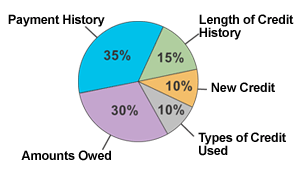How Your Credit Scores Are Calculated
What You Need To Know
Along with credit reports, lenders can also buy your credit score based on the information in the reports. That score is calculated by a mathematical equation that evaluates many types of information that are on your credit report at that agency. By comparing this information to the patterns in hundreds of thousands of past credit reports, the score identifies your level of future credit risk.
FICO® scores are the credit scores most lenders use to determine your credit risk. You have three FICO scores, one for each of the three credit bureaus: Experian, TransUnion, and Equifax. In order for a FICO® score to be calculated on your credit report, the report must contain at least one account which has been open for six months or greater. In addition, the report must contain at least one account that has been updated in the past six months. This ensures that there is enough information - and enough recent information - in your report on which to base a score.
Credit scores are calculated from a lot of different credit data in your credit report. This data can be grouped into five categories as outlined below. The percentages in the chart reflect how important each of the categories is in determining your score.

Chart Breakdown
- Payment History:
- Account payment information on specific types of accounts (credit cards, retail accounts, installment loans, finance company accounts, mortgage, etc.)
- Presence of adverse public records (bankruptcy, judgements, suits, liens, wage attachments, etc.), collection items, and/or delinquency (past due items)
- Severity of delinquency (how long past due) Amount past due on delinquent accounts or collection items
- Time since (recency of) past due items (delinquency), adverse public records (if any), or collection items (if any)
- Number of past due items on file
- Number of accounts paid as agreed
- Account payment information on specific types of accounts (credit cards, retail accounts, installment loans, finance company accounts, mortgage, etc.)
- Amount Owed:
- Amount owed on accounts
- Amount owed on specific types of accounts
- Lack of a specific type of balance, in some cases
- Number of accounts with balances
- Proportion of credit lines used (proportion of balances to total credit limits on certain types of revolving accounts)
- Proportion of installment loan amounts still owing (proportion of balance to original loan amount on certain types of installment loans)
- Length of Credit History:
- Time since accounts opened
- Time since accounts opened, by specific type of account
- Time since account activity
- New Credit:
- Number of recently opened accounts, and proportion of accounts that are recently opened, by type of account
- Number of recent credit inquiries
- Time since recent account opening(s), by type of account
- Time since credit inquiry(s)
- Re-establishment of positive credit history following past payment problems
- Types of Credit Used:
- Credit cards
- Retail accounts
- Installment loans
- Mortgage loans
- Consumer finance accounts

My FICO Booklet
Tips on Improving Your Credit Scores
- Don't Be Late. Missed payments are the single biggest killer of credit scores. Your past behavior, late or missed payments, foreclosures, bankruptcies, etc. counts for one-third of your credit score. Be sure you pay those bills on time.
- Pay Down Balances. Paying down balances is a quick fix. One-third of your credit score is based on the amount you currently owe in relation to your credit limit. Try to keep your balances at 50% or less of your credit limit.
- Keep Old Credit Lines Open. Another 15% of your score comes from how long you've been managing credit. Closing old accounts shortens your credit history and lowers your score. Lenders also take into account the average age of your accounts, so an older account can help balance newer credit.
- Limit New Credit. Take on new credit only when you need it. New credit can hurt your score twice. For starters, new inquiries for credit count for 10% of your score — and a flurry of new credit requests can lower your score. Also, once a new credit line is secured, the average age of your accounts will shorten, which in turn can drag down your score even more.

 Car Buying
Car Buying College Planning
College Planning Computer Safety
Computer Safety Discount Health Plans
Discount Health Plans Final Expense Insurance
Final Expense Insurance Consumer Tips
Consumer Tips Home Buying
Home Buying Home Insurance
Home Insurance Identity Theft
Identity Theft Prescriptions
Prescriptions Shopping
Shopping Travel
Travel Getting Started
Getting Started Debt Roll-Up
Debt Roll-Up Credit Reports
Credit Reports Credit Scores
Credit Scores Credit Repair
Credit Repair Growing Wealth
Growing Wealth Time Value of Money
Time Value of Money Controlling Risk
Controlling Risk Tax Planning
Tax Planning A Balanced Plan
A Balanced Plan Enlisted Pay
Enlisted Pay Officer Pay
Officer Pay Finding a Job
Finding a Job Relief Act
Relief Act Thrift Savings Plan
Thrift Savings Plan VA Education
VA Education VA Home Loans
VA Home Loans VA Health Care
VA Health Care VA Pension Benefits
VA Pension Benefits VGLI
VGLI
